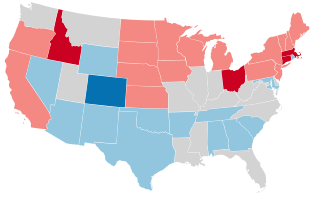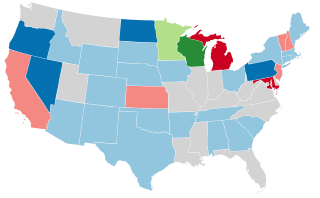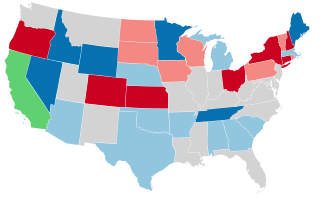
John Hardy Isakson was an American businessman and politician who served as a United States senator from Georgia from 2005 to 2019. A member of the Republican Party, he previously served in the Georgia legislature and the United States House of Representatives.

The 1938 United States Senate elections occurred in the middle of Franklin D. Roosevelt's second term. The 32 seats of Class 3 were contested in regular elections, and special elections were held to fill vacancies. The Republicans gained eight seats from the Democrats, though this occurred after multiple Democratic gains since the 1932 election, leading to the Democrats retaining a commanding lead over the Republicans with more than two-thirds of the legislative chamber.

The 1936 United States Senate elections coincided with the reelection of President Franklin D. Roosevelt. The 32 seats of Class 2 were contested in regular elections, and special elections were held to fill vacancies. The Great Depression continued and voters backed progressive candidates favoring Roosevelt's New Deal in races across the country. The Democrats gained 5 net seats during the election, and in combination with Democratic and Farmer–Labor interim appointments and the defection of George W. Norris from the Republican Party to become independent, the Republicans were reduced to 16 seats. Democrats gained a further two seats due to mid-term vacancies. The Democrats' 77 seats and their 62-seat majority remain their largest in history.

The 1932 United States Senate elections coincided with Democrat Franklin D. Roosevelt's landslide victory over incumbent Herbert Hoover in the presidential election. The 32 seats of Class 3 were contested in regular elections, and special elections were held to fill vacancies.

United States gubernatorial elections were held on November 2, 1954, in 34 states, concurrent with the House and Senate elections. Elections also took place on September 13 in Maine. The special election in Florida was due to the death of incumbent governor Daniel T. McCarty on September 28, 1953.

United States gubernatorial elections were held in 1950, in 33 states, concurrent with the House and Senate elections, on November 7, 1950. Elections took place on September 11 in Maine.

United States gubernatorial elections were held in 1946, in 34 states, concurrent with the House and Senate elections, on November 5, 1946. Elections took place on September 9 in Maine.

United States gubernatorial elections were held in 1942, in 33 states, concurrent with the House and Senate elections, on November 3, 1942. Elections took place on September 14 in Maine.

United States gubernatorial elections were held in 1936, in 34 states, concurrent with the House, Senate elections and presidential election, on November 3, 1936. Elections took place on September 14 in Maine.

United States gubernatorial elections were held in 1934, in 34 states, concurrent with the House and Senate elections, on November 6, 1934. Elections took place on September 10 in Maine.

United States gubernatorial elections were held in 1930, in 33 states, concurrent with the House and Senate elections, on November 4, 1930. Elections took place on September 8 in Maine.

United States gubernatorial elections were held in 1926, in 33 states, concurrent with the House and Senate elections, on November 2, 1926. Elections took place on October 5 in Arkansas, and September 13 in Maine.

United States gubernatorial elections were held in 1922, in 33 states, concurrent with the House and Senate elections, on November 7, 1922. Elections took place on October 3 in Arkansas, and September 11 in Maine.

United States gubernatorial elections were held in 1920, in 35 states, concurrent with the House, Senate elections and presidential election, on November 2, 1920. Elections took place on September 13 in Maine.

United States gubernatorial elections were held in 1916, in 36 states, concurrent with the House, Senate elections and presidential election, on November 7, 1916. Elections took place on September 11 in Maine.

United States gubernatorial elections were held in 1914, in 31 states, concurrent with the House and Senate elections, on November 3, 1914.

United States gubernatorial elections were held in 1912, in 33 states, concurrent with the House, Senate elections and presidential election, on November 5, 1912. In addition, there was a special election in Georgia on January 10, 1912.

United States gubernatorial elections were held in 1908, in 33 states, concurrent with the House, Senate elections and presidential election, on November 3, 1908.

United States gubernatorial elections were held in 1906, in 28 states, concurrent with the House and Senate elections, on November 6, 1906.

United States gubernatorial elections were held in 1902, in 27 states, concurrent with the House and Senate elections, on November 4, 1902.




















